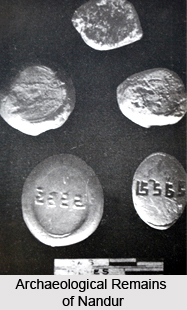Nandur is located on the bank of River Betravati, in the west of Mandideep and between Bhopal and Itarsi junction, Madhya Pradesh. It has been a significant site of archaeology and various excavations in this region have furnished a number of ancient artefacts. S. K. Pandey had directed the Department of Ancient Indian History Culture and Archaeology, University of Sagar and K. K. Chakravarty and M. D. Khar directed the Directorate of Archaeology to carry out various excavations that led to the discovery of archaeological items belonging to different eras.
5th to 4th century B.C. Artefacts of Nandur
Artefacts of this period include wheel-made pottery. Thin and deep bowls made of red or black ware and some having very fine fabric are some of the common excavated items of this era.
 4th to 3rd century B.C. Artefacts of Nandur
4th to 3rd century B.C. Artefacts of Nandur
Red and black slipped wares are representatives of this era. The antiquities of this period also include cast and punch marked coins, bone stylus, one carnelian bead, terracotta human figurine and copper antimony rod.
2nd century B.C. to 1st century A.D. Artefacts of Nandur
Artefacts of this period exhibit earlier influences like the ceramic tradition prevailing in the previous periods. However, some new creations have also marked their presence in this era. These items include bowls with lid, wide mouthed basins, terracotta and shell bangles, copper coins, iron objects and terracotta beads.
1st century A.D. to 4th century A.D. Artefacts of Nandur
This era had articles like stamped and painted pottery and seals with inscriptions Ksatrapa and Kushana periods.
4th century to 6th century A.D. Artefacts of Nandur
Articles like sealings having inscriptions, scales and grey ware pottery had marked their presence in this period. Numerous architectural ruins had also been excavated in this era like a ringwell, a brick well etc. Pottery comprised of coarse red ware, red ware having yellow cream slip having black bands and black ware. Terracotta sealings belonging to Ksatrapa and Gupta period are also common. A signet ring of Devadasa, a ruler, was also discovered during the excavations. Sealings with inscriptions in Brahmi characters have also been found. Silver coins, terracotta and ivory idols, terracotta beads, copper wheel, semi- precious stones, arrow- heads, antimony rod, iron objects used in daily life have also been found in Nandur.
Excavations in this Nandur had been carried out during 1982-83. On the basis of revealed artefacts the reigns of various dynasties have been established in Nandur during different eras. Excavations have established that the period between 7th to 4th centuries B.C. belonged to Pre Mauryan era, from 4th to 2nd century B.C. belonged to Maurya Empire, from 2nd century B.C. to 2nd century A.D. was ruled by the Sungas, up to 4th Century A.D. was ruled by Kshatrapa-Naga and from 4th to 6th century A.D. belonged to Gupta Empire. The period from 7th century A.D. has been established as medieval period.



















